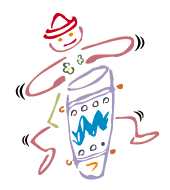The first objective in controlling phrase lengths in
improvisation is learning to produce nice flowing phrases of 2
and 4 bars length. This also helps you to keep track of where you
are in a song's chord progression.

Once you get on top of this objective you are ready for the next
step : learning to vary your phrase
length and to be able to start and
end a phrase at any point in the chord
progression.
This ability adds great interest to your solo,
but takes some considerable practice to master.
A good vehicle
for such practice is the 12 bar blues format. For note selection
use the minor pentatonic scale, the blues scale, or the
appropriate Mixolydian modes.
There are three progressive steps
for practice.
- Example A - vary phrase
length from 1 to 4 bars in length within the three natural 4
bar phrases of the blues progression.
(The colours show
phrase lengths : 2 bars - 2 bars - 4 bars - 2 bars - 2 bars)
- Example B - vary phrase
length from 1 to 4 bars in length.
This time extend phrases
across the ending points of the natural 4 bar phrases of
the blues progression.
(Phrase lengths : 2 bars - 4 bars - 4 bars - 2 bars)
- Example C - vary phrase
length from 1 to 6 bars in length.
Extend phrases across the
ending points of the natural 4 bar phrases and also from one
blues chorus into the next.